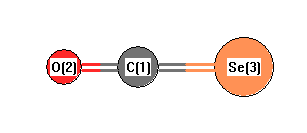Vibrational Frequencies calculated at B2PLYP=FULL/6-31G(2df,p)
| Mode Number |
Symmetry |
Frequency
(cm-1) |
Scaled Frequency
(cm-1) |
IR Intensities
(km mol-1) |
Raman Act
(Å4/u) |
Dep P |
Dep U |
|---|
| 1 |
Σ |
2107 |
2107 |
586.97 |
20.92 |
0.59 |
0.74 |
| 2 |
Σ |
715 |
715 |
2.63 |
17.83 |
0.17 |
0.29 |
| 3 |
Π |
511 |
511 |
0.90 |
0.33 |
0.75 |
0.86 |
| 3 |
Π |
511 |
511 |
0.90 |
0.33 |
0.75 |
0.86 |
Unscaled Zero Point Vibrational Energy (zpe) 1921.7 cm
-1
Scaled (by 1) Zero Point Vibrational Energy (zpe) 1921.7 cm
-1
See section
III.C.1 List or set vibrational scaling factors
to change the scale factors used here.
See section
III.C.2
Calculate a vibrational scaling factor for a given set of molecules
to determine the least squares best scaling factor.
